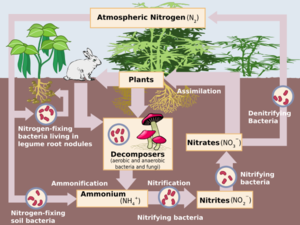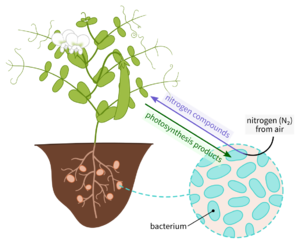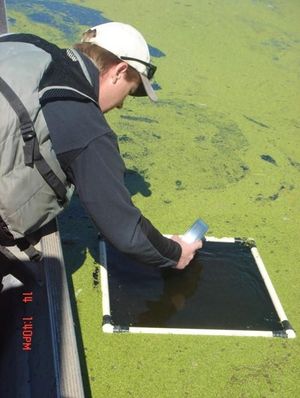Nitrogen cycle
The nitrogen cycle is a repeating circulation of the element nitrogen in various chemical forms throughout living and non-living things on Earth. By changing forms nitrogen is able to move from the atmosphere, as a gas, to a form that is usable by plant life. The nitrogen cycle can be divided into several processes including: nitrogen fixation, assimilation, ammonification, nitrification, and denitrification. Other processes have been considered in this cycle as scientific research continues.[1]

The nitrogen cycle allows for the continued maintenance of healthy productive ecosystems. The alteration of nitrogen levels can greatly affect plant production and biomass in our environment. The nitrogen cycle allows us to understand how to better grow crops in agriculture to maintain a food supply for the human population but also limit fertilizer pollution in soils that can lead to eutrophication.
Nitrogen
Nitrogen is a critical nutrient in the survival and success of all organisms [2]. Around 78% of the Earth’s atmosphere is made up of nitrogen. This nitrogen in the atmosphere occurs as dinitrogen gas (N2) and is unable to be used directly by living organisms such as plants which can limit nitrogen availability ecosystems [3]. The nitrogen cycle is a key component in many ecosystem processes such as decomposition and primary production. Nitrogen availability can alter the rate of these processes. Nitrogen has several forms including dinitrogen gas (N2), nitrogen oxide (NO), nitrogen dioxide (NO2), ammonia (NH3), ammonium (NH4 +), and ammonium nitrate (NH4NO3).
Processes
Through a series of processes nitrogen can be converted by microbial activities through fixation, assimilation, ammonification, nitrification, and denitrification.[4] These processes make up the nitrogen cycle and play an important role for all living organisms on Earth.
Nitrogen fixation:
Nitrogen fixation is the process by which nitrogen gas (N2), is transformed into ammonium (NH4-), a form of nitrogen that can be used by plants. Through this process nitrogen is moved from the atmosphere into the soil where plants can absorb it through their root system. A small percentage of fixation can occur via abiotic activities such as lightening. A majority of nitrogen fixation occurs naturally in

soils by bacteria that have a symbiotic relationship with the plants [5]. In exchange for energy from photosynthesis the bacteria will fix nitrogen into a usable form for the plant by using the enzyme nitrogenase. Nitrogen fixation by bacteria can also produce forms of nitrogen that can be utilized by various organisms. This fixation process requires a great deal of energy and therefore uses a lot of ATP.
A common symbiont, nitrogen fixing bacteria, fix the most nitrogen. The two most common of these symbiotic bacteria are Rhizobium and Bradyrhizobium. Both of these bacteria are able to invade the roots of legume plants. These bacteria provide plants with usable nitrogen to assist with protein production and the plants provide energy in the form of carbon for the symbiont bacteria. this process is beneficial to agriculture as leguminous plants can assist with returning nitrogen into the soil to promote plant growth. Many farmers will use a crop rotation system where leguminous plants, such as alfalfa, will be grown and then plowed back into the soil to increase nitrogen availability for crops the following year.
Assimilation:
Assimilation of inorganic nitrogen is the process by which organic nitrogen compounds form from inorganic nitrogen compounds in an ecosystem. Plants use these ions to make proteins and nucleic acids [6]. Nitrogen assimilation requires ATP and reduced ferredoxin from photosynthesizing cells in plants [7]. The assimilation process occurs when nitrates enter a cell and are reduced to ammonia.

This ammonia is then incorporated into organic compounds through the glutamine synthetase- glutamate synthase pathway (see figure 3). Through this pathway ammonia and glutamate are catalyzed by glutamine synthase into glutamine. Glutamine is then catalyzed by glutamate synthase into two glutamate molecules. One of these molecules will go back into the pathway, the other goes into transamination reactions to form other amino acids.
Ammonification/ Mineralization:
Soil nitrogen can be derived from dead organic materials. Ammonification or mineralization is the process where bacteria incorporate nitrogen into amino acids and release the excess nitrogen as ammonium ions (NH4+) into the soil. These ammonium ions are then readily available for uptake by plants for protein synthesis and microorganisms that require it for growth [8].

Nitrification:
Nitrification is a two-part oxidation process of ammonium ions into nitrates and nitrites moderated by many microbial communities in the ecosystem [9]. This process provides extra available nitrogen for plants to take in via their roots. Through the process of nitrification, ammonium, produced by ammonification, found in soils is transformed into nitrites (NO2-) and nitrates (NO3-). Nitrates are able to be used by plants and plant consuming animals and are formed by ammonia-oxidizing bacteria. Nitrites are not readily available to plants and animal but can be converted to nitrates by bacteria. These nitrite-oxidizing bacteria, nitrobacteria, receive energy in exchange for this process [10]. Nitrate is the form most living plants use to absorb nitrogen.
Denitrification:
Denitrification follows the process of nitrification and is where nitrates are returned to the atmosphere as nitrogen gas by denitrifying bacteria in soils [6]. Denitrification generally occurs in anoxic environments with exhausted oxygen levels. This process can lead to a loss in soil nitrogen content which needs to be replaced. Denitrification can also occur during the process of harvesting crops, soil erosion, burning, and leaching.
Anthropogenic Changes:
Anthropogenic activities have greatly altered the nitrogen cycle through, fossil fuel combustion, extensive cultivation of legumes and the construction of fertilizers using the Haber-Bosch process. The human use of nitrogen fixation has increased food production but has led to an increase in nitrogen being emitted into the atmosphere [12]. This build up of excess nitrogen can drain from soils into water sources underground or enter water systems via runoff. Nitrogen build up leads to eutrophication, shown in figure 4, extreme nitrogen levels, leading to issues such as algae blooms due to nitrogen enrichment in the water. This process can decrease oxygen level and have a more last effect on an aquatic system.
References
1. Stein, L. Y., and M. G. Klotz. 2016. The nitrogen cycle. Current Biology 26:R94–R98.
2. LeBauer, D. S., and K. K. Treseder. 2008. Nitrogen Limitation of Net Primary Productivity in Terrestrial Ecosystems Is Globally Distributed. Ecology 89:371–379.
3. Ollivier, J., S. Töwe, A. Bannert, B. Hai, E.-M. Kastl, A. Meyer, M. X. Su, K. Kleineidam, and M. Schloter. 2011. Nitrogen turnover in soil and global change: Key players of soil nitrogen cycle. FEMS Microbiology Ecology 78:3–16.
4. Meng, L., W. Li, S. Zhang, C. Wu, and L. Lv. 2017. Feasibility of co-composting of sewage sludge, spent mushroom substrate and wheat straw. Bioresource Technology 226:39–45.
5. Peoples, M. B., D. F. Herridge, and J. K. Ladha. 1995. Biological nitrogen fixation: An efficient source of nitrogen for sustainable agricultural production? Plant and Soil 174:3–28.
6. Mader, Sylvia S., and Michael Windelspecht. Essentials of Biology. 11th ed., McGraw-Hill Education, 2017.
7. Raven, Peter H., Ray Franklin Evert, and Susan E. Eichhorn. Biology of Plants. New York: W.H. Freeman and Co, 2005.
8. Fath, B. D. 2018. Encyclopedia of Ecology. Elsevier, San Diego, NETHERLANDS, THE.
9. Sims, J. T., and D. C. Wolf. 1994. Poultry Waste Management: Agricultural and Environmental Issues. Pages 1–83 in D. L. Sparks, editor. Advances in Agronomy. Academic Press.
10. Cáceres, R., K. Malińska, and O. Marfà. 2018. Nitrification within composting: A review. Waste Management 72:119–137.
11. Gu, B., Y. Ge, Y. Ren, B. Xu, W. Luo, H. Jiang, B. Gu, and J. Chang. 2012. Atmospheric Reactive Nitrogen in China: Sources, Recent Trends, and Damage Costs. Environmental Science & Technology 46:9420–9427.
12. Nitrogen_Cycle.jpg: Environmental Protection Agency[1]
13. https://en.wikipedia.org/wiki/File:Nitrogen_fixation_Fabaceae_en.svg [2]
15. Collecting Water Nutrient Data. (n.d.). . https://www.usgs.gov/media/images/collecting-water-nutrient-data.